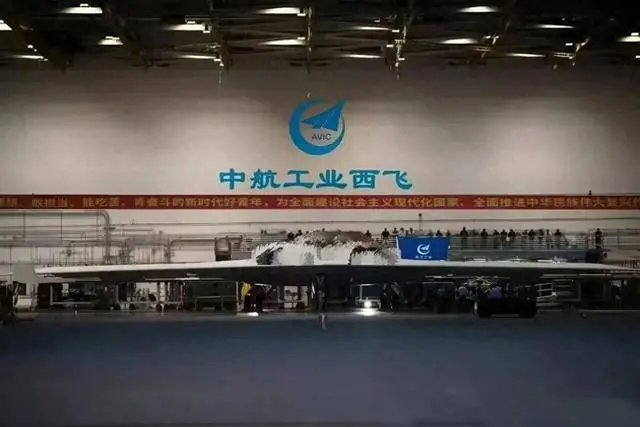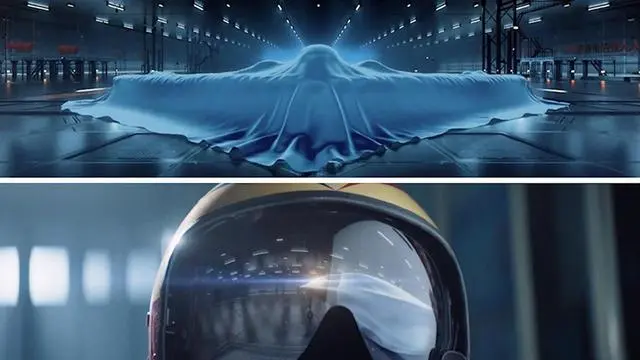Air Force Deputy Commander Wang Wei, who attended the Two Sessions, revealed in an interview with the Hong Kong Commercial Daily that the H-20 will be officially unveiled soon and stated that there are no major technological bottlenecks. It has been continuously upgraded and modified, which is very exciting news! Just shortly after Deputy Commander Wang’s interview, a mysterious flying wing aircraft photo with the background of AVIC Xi’an Aircraft Industry Group suddenly appeared on social media. The author of the social media post claimed that the suspected H-20 had been unveiled. Is this really true?
The authenticity of the photo: not just this one incident
The features of the photo are still quite obvious. Although there is only one frontal photo, and it is heavily pixelated, many important details can still be discerned. Firstly, the characteristics of the aircraft’s aerodynamic layout are consistent with those of the H-20. It’s evident from the photo that it’s a flying wing aircraft, although the core fuselage and engine intake parts are pixelated, it’s still apparent that this is a flying wing aircraft with no vertical tail, as there’s no protruding vertical tail feature visible at the rear of the aircraft, which basically aligns with our imagination of the H-20.
Another notable aspect is the background, with AVIC’s logo and the presence of AVIC Xi’an Aircraft Industry Group. According to information from various sources, Xi’an Aircraft Industry Group, a subsidiary of AVIC, is responsible for designing and manufacturing the H-20 bomber. The presence of this logo in the photo is in line with expectations. Additionally, there is an extremely long slogan below:
“(Have) ideals, dare to take on responsibilities, willing to endure hardships, and ready to strive for the great rejuvenation of the Chinese nation by building a socialist modernized country comprehensively…”
This seems to fit our expectations as well. With the logo and slogan, our minds are directly led to Xi’an Aircraft Industry Group’s production base. The photo was released on the same day as Deputy Commander Wang’s interview, but what does this mean exactly? Did Xi’an Aircraft Industry Group really release the photo of the H-20?
H-20: Why a flying wing?
Some definitions mentioned earlier might not be readily accepted by many netizens. Why does a flying wing conform to the aerodynamic layout of the H-20, and why couldn’t it be something else? Well, the answer is that it could be something else, but currently, the aerodynamic layout of a flying wing is very much in line with the positioning of a stealth bomber. The reason is quite simple: the Radar Cross Section (RCS) of a flying wing is the smallest.
A flying wing is an aircraft without a tail and with the main body hidden within thick wings. For any aircraft flying aerodynamically, wings are necessary. Therefore, theoretically, it’s feasible to remove all other unnecessary components in the design, although some flying wing aircraft do retain a fuselage, they certainly lack a tail.
As for whether there’s a vertical tail, it depends on the design. Early flying wings did have vertical tails, such as the YB-49 flying wing developed by Northrop Corporation, which had four vertical fins as stabilizers. However, flight tests proved that these fins were insufficient for maintaining stable flight direction, indicating inadequate surface area. So, why do later aircraft like the B-2 and B-21 not have vertical tails? There are two reasons:
One is the pursuit of minimal RCS area. A large vertical tail would significantly increase the RCS, especially in the lateral direction, so aircraft striving for optimal stealth would inevitably eliminate the vertical tail to achieve superior stealth performance.
The other reason is the implementation of computer-controlled directional stability through digital fly-by-wire systems. Without a vertical tail, the aircraft would experience “yawing” during flight, and could even fly sideways, leading to crashes. However, with a digital fly-by-wire system, the onboard computer can control the left and right spoiler panels differentially to maintain directional stability.
The B-2 benefited from early fly-by-wire systems, which allowed it to eliminate the vertical tail. Combined with its thin, smoothly blended wings and fuselage, cockpit coating, serration at the seams to reduce radar emissions, and techniques such as rearward positioning of engines and exhaust nozzles for infrared stealth, the B-2 achieved excellent stealth performance in both radar and infrared bands.
These modifications reduced the B-2’s radar cross-section to 0.001 square meters, making it virtually undetectable in enemy airspace. Precision bombing missions deep inside enemy territory and penetrating air defenses were specialties of the B-2. There are even rumors that during the Singapore Airshow, the B-2 approached Changi Airport without being detected by air traffic control radar.
The B-21 is an “upgrade” of the B-2, although it’s slightly smaller in size, it still retains the basic features of the B-2, demonstrating the success of the B-2’s design! With blueprints from the B-2 and B-21, there’s no reason for the H-20 to innovate further. The US Air Force has tested these designs for decades. Just refer directly to these two models’ aerodynamic layouts and make slight modifications based on our needs. It’s convenient and reassuring, isn’t it?
Therefore, although the military has not yet disclosed the data of the H-20, netizens have already speculated various parameters of the H-20. For example, the most widely circulated information online includes:
The H-20 features a flying wing layout, and rumors suggest it’s slightly larger in size than the B-2. According to data reported by multiple media outlets, the maximum takeoff weight of the H-20 is around 150 to 200 tons, with a payload of about 45 tons. It can attain high hypersonic speeds and carry four hypersonic missiles.
CG images of the aerodynamic layout have also been widely circulated, mainly divided into versions with and without vertical tails. However, these are creations of enthusiasts catering to different preferences. The version widely accepted by the public is the one depicted below, which the author also finds more credible:
So theoretically, if Xi’an Aircraft Industry Group were to unveil the H-20 and capture it from the front, the image circulating on social media would indeed have some validity. However, unfortunately, this image is actually a creation by a knowledgeable individual who understands China’s aviation industry, based on the B-21 tested by the US military:
In fact, there are many inconsistencies in the above image. For example, the logo and font of Xi’an Aircraft Industry Group do not match those officially released. Additionally, the slogan below is too verbose. Generally, images released by Xi’an Aircraft Industry Group would have at most a dozen words in the slogan. Even for model declarations, simpler and more direct slogans such as “Remembering our mission, firm in our confidence, daring to strive, and determined to win…” are preferred, which are more suitable for encouraging aspiring youth on the streets.
Why hasn’t it been announced yet? What exactly is being upgraded?
On December 2, 2022, the B-21 made its first public appearance at Air Force Plant 42 in Palmdale, California. There were rumors at that time that China’s H-20 would also be unveiled around the same time. However, more than a year after the B-21’s debut, there has been no sign of the H-20. Some foreign media outlets claim that the H-20 project has encountered major difficulties and is struggling to progress.
Various rumors have been circulating, but after Air Force Deputy Commander Wang Wei’s press briefing, it was confirmed that the H-20 project is not only progressing smoothly but is also very close to being unveiled. The delay in the H-20’s unveiling is simply due to “continuous upgrades,” and it will soon be revealed. At that time, the world’s third stealth bomber will emerge, exerting immense pressure on the US military. After all, China is one of only two countries capable of producing bombers of the same level as the US military. The US also perceives China as a threat to its global leadership position, leading to inevitable comparisons between the two sides.
The Deputy Commander’s response to the press undoubtedly instilled great confidence in everyone. However, the question remains: what exactly is being upgraded while it hasn’t been unveiled yet? This question is not easy to answer. However, there was a previous rumor circulating on social media that the H-20 is upgrading its internal bomb bay to accommodate hypersonic missiles. Although this claim cannot be confirmed, it seems reasonable.
This is because the period when the H-20 is being finalized coincides with the rapid advancement of China’s hypersonic weapons. The H-20’s weapon mounting coincidentally aligns with hypersonic missiles. Unlike conventional long-range air-to-air missiles, hypersonic missiles, such as glide hypersonic missiles, have a long boost phase, which extends the length of the entire missile to around 6 to 7 meters. A conventional bomb bay cannot accommodate such missiles. However, for a stealth bomber like the H-20, integrating hypersonic missiles would exponentially increase its strike and deterrence capabilities. Therefore, upgrading the bomb bay seems a plausible conclusion.
Another speculation involves laser weapons. Although similar claims have surfaced on social media, it seems unlikely. However, the possibility of upgrading AI-controlled loyal drones still exists. Since this does not necessarily require hardware changes, it can be upgraded gradually alongside the public unveiling, without the need to “hide away” for upgrades. Therefore, the likelihood of this possibility is almost negligible.

